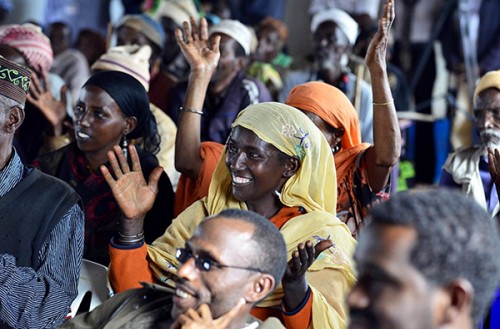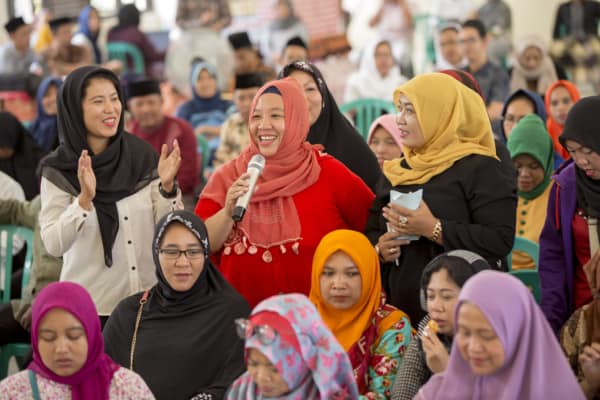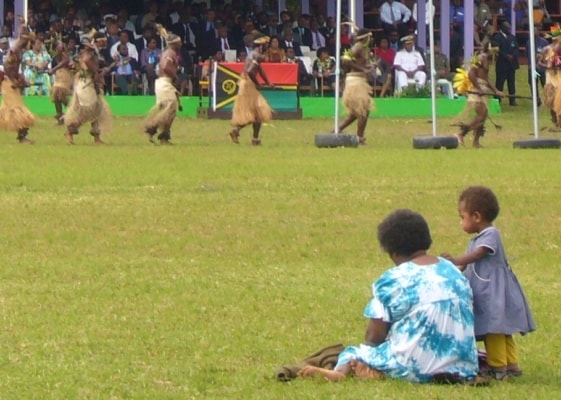Image: A village meeting in Kenya (Neil Palmer/ CIAT, Flickr).
The World’s Women 2015, recently released by the UN, tells us that in 2015 women held 22% of parliamentary seats – almost double the level recorded in 1997 (12%).
But take a look at the latest available data showing which of the world’s parliaments have the highest proportions of women (981 KB PDF). In first place, Rwanda; in fifth, South Africa; at 41, Afghanistan and at 45, South Sudan; way down at 64, the UK and, even lower, the USA which shares 84th place with San Marino. Would anyone argue that this tells us which countries are more ‘gender equitable’ than others?
In its statistical summary of how women are faring around the world, the UN notes the ‘growing availability’ of sex disaggregated data and, of course, this is good news. But collecting separate data on males and females should be an absolute minimum requirement for all interventions.
And, while it provides much-needed basic information about an intervention’s ‘reach’, sex-disaggregated data tells us almost nothing about the gender-related impact of an intervention – because gender is not about men versus women. Injustice and inequality are not written into our chromosomes.
Fifteen years ago, Andrea Cornwall wrote that one of the biggest challenges for international development in effectively promoting change is the ‘pervasive slippage between “involving women” and “addressing gender”’. The same remains true today. Showing an increase in the number of women participants in an intervention is not the same as demonstrating gender impact.
In Addressing Gender in Impact Evaluation: What Should be Considered? (ODI), I’ve tried to show that gender is a process of judgement and values linked to stereotypes and norms about masculinity or femininity, regardless of somone’s born sex category. It is, of course, intimately entwined with sexuality and with other social hierarchies such as race or ethnicity; class, caste and socio-economic status; age; and, obviously, religious beliefs.
So, for instance, the IPU league table of parliamentary women illustrates well how projects to increase the number of women in politics don’t necessarily address stereotypes and norms around gender and politics. What if numbers increase but people still believe that a woman in politics has to ‘act like a (particular type of) man’? What if women in politics always end up in charge of social services ‘because they are more caring’? Did Margaret Thatcher help to challenge gender norms, or to reinforce them?
Gender affects everyone, all of the time. It affects the way we see each other, the way we interact, the institutions we create, the ways in which those institutions operate, and who benefits or suffers as a result of this. This is as true in an international development context as it is in any other.
So how can we do gender impact assessment differently? First, we need to build general agreement that when we talk about ‘gender’, we are talking about a social process of judgement and inequality.
Next, any assessment should start with a description of the major gender stereotypes, norms and judgements that hold sway in the context we want to assess. This should include conscious consideration of the beliefs of intervention staff members as well as community members. We need to think about how these perceptions might affect both interpretation and implementation of the intervention, particularly where they inform power and decision-making.
Clear answers to a range of questions about commonly-held beliefs are the solid foundation of good gender impact assessment. For instance:
- Should decision-making power in the community only be held by certain types of men? (for example, men who are middle-aged, middle or upper class, belonging to the dominant ethnic group, those seen as physically and mentally ‘strong’).
- Should only certain types of women be allowed to express an opinion on community matters? (for example, women judged ‘good’ because they are married, middle-aged, middle or upper class, or belong to the dominant ethnic group).
- Even when women are allowed to express an opinion, must they then leave the final decision to male power-holders?
- Are women who are believed to have transgressed norms of sexual behaviour stigmatised and excluded from power and decision-making?
- Should young women be seen and not heard?
- Are young men assumed to be ‘hot-headed’ and therefore are not to be taken seriously?
An intervention’s impact on gender is best measured by asking whether stereotypes and norms like these changed for the better (or, indeed, for the worse) during the life of the project. Put simply, the question to ask is not ‘how many’ of anything, but whether anything changed for the participants, male or female.









